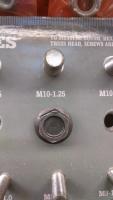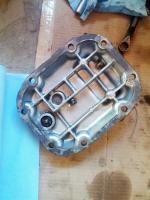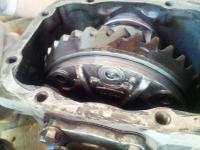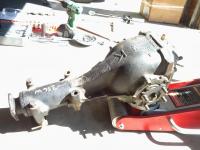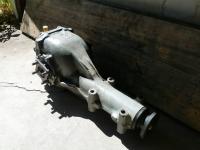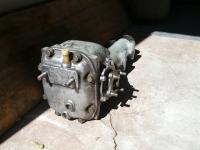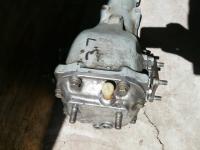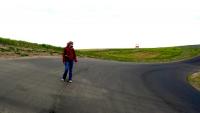-
260z Brake Failure - Jump, Roll & Fire
The neck is sore but getting better. I didn't have any pain until the first night which made it difficult to sleep. X rays were done 2 days after the crash just to be safe. Doctor confirmed that it's likely only sore muscles because the pain didn't come until later. The ground was super soft. I think it gets flooded in that area when it rains. My wife would probably kill me if I got into that car again but everytime I look at in the garage it doesn't look too bad. I haven't had the car in the air yet but it would need. All the safety stuff is one time use. radiatorengine mountsfront left suspension is goneleft fender bodywork & possibly the hoodhood and front fenders would need paintingbatteryhosesairboxcarb plungersredo the melted wiringclutch linefuel connectorbeltsseathelmetneck restraintwindshieldThe strut bar snapped which leads me to believe the chassis is twisted. I know nothing about straightening a car.
-
260z Brake Failure - Jump, Roll & Fire
There is a switch in the car which I should've hit on my way out. Race cars are required to have a master kill switch for the safety crew. On this car the kill switch was located on right side. Right where the wind was blowing the fire which is why it took them so long to kill the pump. Here are some photos of the car after the crash. https://plus.google.com/photos/112123514603850174327/albums/6153338453838253233?authkey=CJCcwvv_sOCdLg
-
260z Brake Failure - Jump, Roll & Fire
The fuel pump was wired by a previous owner and something I had never considered. http://www.how-to-build-hotrods.com/electric-fuel-pump.html
-
260z Brake Failure - Jump, Roll & Fire
The brake pedal still has pressure despite the crash and the front fluid reservoir being ripped off. But my neck is too sore for me to be wrenching on the car to dive deeper.
-
260z Brake Failure - Jump, Roll & Fire
Once my neck isn't so sore I plan to part out the car and try to find all of the spare parts and wheels a new good home. I think I'm going to move on to something with fuel injection and no drum brakes. https://www.youtube.com/watch?v=AeqNnZbC1Z0
-
Z Noise
Never give up! Turned out to be the stupid alternator. A friend suggested starting the car with the belt off to ensure it wasn't the water pump. Just by removing the belt and trying to spin the water pump or the alternator I could tell the alternator was messed up. This alternator had 600 miles on and 20 hours. A clip of the engine with the new alternator and I promise it sounds much louder in person. The smoke we're suspecting may be from the carbs running so rich and the blue tint may be from the camera phone. It doesn't look nearly as blue in person. I did do a bunch more work before figuring out it was the alternator. Retorqued the head bolts (they were a bit loose) Retarded timing from 44 degrees at 4000 RPM to 36 degrees Best valve job I've ever done in my life. I used the feeler gauges that were one size smaller and larger then what I was adjusting the valve to get an idea of how loose/tight it was in comparison. Synced the carbs but they were pretty synced to begin with. Finally a proper compression test. Before I didn't have the throttle wide open nor did I do a dry vs wet comparison. The new numbers. My gauge has marks in 5 psi increments so - is like 3-4 psi and + is like 1-2 psi more then the number. 1 - 180+ 200+ 2 - 180- 190+ 3 - 160+ 170+ 4 - 170- 195 5 - 180- 195 6 - 165 190- Funny story about the alternator. I asked the guy at Napa when I bought it about the warranty because O'reillys sell alternators with a lifetime warranty. Napa guy says "everything I've bought from O'reilly I've had to take back." They took it back no questions asked and they had never seen one come back like this.
-
Z Noise
I think olzed is correct. Heres a video showing a vacuum test with the engine warm. Oil temps were just under 160F and coolant around there as well. Oil pressure is good and EGTs were around 600F which I think is about right for idling. Vacuum gauge read about 17 at idle. Sadly blipping the throttle the gauge drops to 0 and back up to 20+. Optimistically it could just be the mixture is too rich but I don't think it would drop to zero if the rings would good. Maybe someone with a bit more experience can chime in. Technical Articles: Engine testing with a Vacuum Gauge - at Greg's Engine & Machine Rest of the video shows the sight windows on the carbs and gain in RPM speed when I open the throttle on each carb individually. It also shows the slides moving and dropping freely so no stuck needles. Finally the video ends with nice clip of blue smoke coming out the exhaust. I'll grab a picture if anyone is interested but near the exhaust tip my garage has a spray of oil. It's not on the video but just before I shut the car off a gruesome metal clanking was coming from the engine which sounds like my co-worker's jeep that has a bad piston pin. This will be the 2nd bottom end of mine. The first threw a rod. This bottom end has about 23 hours or 600 miles on it. We had a engine builder replace the rings of this engine which the previous owner said was low on compression. Ran this engine with Mobil one 15w50 for the added zinc. I tried to avoid the revving the engine up until it was warm. After the last bottom end I babied this one. I have junkyard engine that I think I'm just going to throw in the car and try to run it until it goes. I'll probably replace the gasket and seals before hand. Thanks for everyone's help I appreciate it. Vacuum tests are awesome btw.
-
Z Noise
Sorry by "horrible" I meant the sound in the video. It hasn't changed despite the work I've done. It's hard for me to describe my first thought was it was a really bad exhaust leak or valve noise. A friend of mine who's a experienced mechanic thought it wasn't running on all cylinders based on the video. I like the suggestion about trying to feed one carb or the other. Both raise the RPMs. I'll snag a video of it after my phone charges a bit. The sight windows look pretty identical. I don't think these are stock needles and it probably is running rich at idle. The new spark plugs looked rich when I pulled them. Usually the car is extremely hard to start when it's cold because the choke has been removed but since February it's been really easy to start. Prior to that I'd have to use starter fluid and cycle the throttle every second for about a minute trying to start the car.
-
Z Noise
Gas is non-ethanol and was bought around March 22nd so it's only a couple of weeks old. I pulled the tube off just to make sure my make shift gasket wasn't covering the oil feed line and it isn't. Hmy wife crank the engine while I watched the oil drip out of the oil tube. All 12 holes look good. I also pulled the brake boost vacuum line and covered the hole on the intake manifold with my hand. No noticeable change in RPM speed. After all of these the EGTs are now even which is a bonus I guess. I'll readjust the valves on 2 & 4 after the engine cools and I've had lunch.
-
Z Noise
Latest video I've taken of the engine running. Background ITS 260z car so yes it has to keep the flat top carbs. Car was dynoed tuned last year I think and ran fine at the SCCA school (March). When we went to unload the car from the trailer it sounded horrible. I'm suppose to be at the race track today. Things Tried Pulled the headers and re-wrapped them to ensure there were no holes or cracks. New intake/exhaust manifold gasket. New spark plugs, wires, cap & rotor. Cleaned the carb slides. Also tried swapping the slides between the front and rear carbs. Compression test looked good. 155/145/150/130/150/150 (psi read from cylinder 6 to 1) Replaced a couple of gaskets on the front carb since it seemed like it was leaking. Float bowl wasn't stuck or anything. Adjusted the valves. They were pretty good to begin with. Things Observed EGT probes on cylinder 1 & 6 display 300F and 600F respectively. Fuel level in the carb windows seem identical. By pulling 3 spark plug wires the car runs better on the rear 3 cylinders. Attemped to pull one wire at a time and it was difficult to notice a RPM drop. However when I pull 3 wires and plug one back in it's easy to notice a RPM increase. My gut says theres spark. Observed the slides moving up and down with the car running, airbox off and fiddling with the throttle. 3.5psi Fuel pressure gauge just before the carbs.
-
Clunk, Pop and Whine goes the differential
I took the diff apart and found some metal pieces. I'm currently looking for a set of these ring bolts and I'm not having much luck. Any suggestions? I stopped by home depot to measure it and it's a m10 1.25. I did think of pulling one out of the welded diff but they're different. After thinking about it maybe it's not such a good idea to reuse ring bolts.
-
Clunk, Pop and Whine goes the differential
Out of curosity what tipped you off that it's a R180 diff? According to the notes I recieved with the car it's an LSD. This is my first time opening up a diff so I'm still learning. The pictures are a bit misleading. We removed some of the ring bolts by hand that were loose along with broken saftey wire. The center bolt is sheared and the other half was found in the cover. The metal drain plug also had a good amount of metal shavings but I didn't notice much in the fluid as it drained.
-
Clunk, Pop and Whine goes the differential
Heres the damage. My guess the safety wire went at some point and a bolt was able to wiggle it's way out. The new diff that went in. Question about the vent? at the top of the diff. Does that need some sort of cover is it fine to run it like so? The old diff. Any thoughts on having the diff rebuilt vs buying another used one? Thanks for your help.
-
Clunk, Pop and Whine goes the differential
That's the sound that came from the rear of the car as I came around the "half pipe" turn at Oregon Raceway Park. Immediately I put the clutch in which made the whining noise go away and got a flat tow back into the paddock. Jacked the car up and with the transmission in neutral the rear wheels will spin forward but lock in reverse. We disconnected the rear shafts so we could get the car off the trailer once we got home. This weekend I plan to drop the diff and start poking around. Has anyone seen this issue before? I tried searching but I keep finding posts about doing donuts instead of diagnosing differential issues. Anyone have of a good link for identifying what kind of differential I have? The car itself is a race prepped car I bought from someone else and I'm just starting to learn about Zs. Here is a plug and picture of the turn at ORP. We were running anti-clockwise and I was transitioning the weight when it went. I think I was hearing the clunking around other turns as well but I'm still learning the car so I haven't quite figured which noises are good and bad yet.
-
Racing Flat Top Carbs
Has anyone had any experience or tips for tuning these carbs for specifically for racing? I recently bought a ITS prepped 260z with the flat tops. All the emission stuff is plugged and the choke removed. The car has EGTs which show about 1100F at WOT on the straights. Last weekend we had a test and tune day at Oregon Raceway Park. The track is at about 2300ft elevation and the temperature was in the low 40 to mid 40's that day. We pulled the carbs and measured the needle at 45mm. We tried moving the needle to 45.5mm, 46.5mm and backwards to 44mm. EGTs still read 1100F except for the 44mm which was at 900F. Tomorrow we're planning to check the valves and do a compression test. What oil do you guys run in your carbs? How much oil? Got any other suggestions?
Important Information
By using this site, you agree to our Privacy Policy and Guidelines. We have placed cookies on your device to help make this website better. You can adjust your cookie settings, otherwise we'll assume you're okay to continue.




